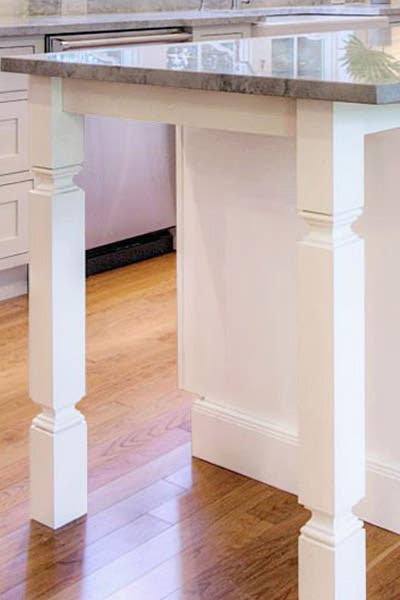Crucial Elements to Consider When Picking Legs For Cooking Area Island
Selecting the proper legs for a kitchen island involves a cautious evaluation of several factors that can dramatically influence both performance and visual allure. As we discover these aspects, it ends up being clear that each decision can have far-reaching ramifications for the overall cooking area experience.
Product Options
When picking legs for a kitchen area island, comprehending the different material alternatives is crucial for attaining both visual appeal and structural integrity (Legs For Kitchen Island). The choice of material dramatically influences not only the sturdiness of the island yet also its general layout and performance
Steel legs, commonly made from stainless steel or functioned iron, add a commercial and modern feel while making sure sturdiness and security. These materials are resistant to put on and can sustain considerable weight, making them optimal for bigger islands.
Another choice is crafted materials, like MDF or plywood, which can be more affordable while still supplying a series of surfaces. They may not provide the same degree of security as solid timber or steel. Legs For Kitchen Island. Finally, materials such as acrylic or glass can create a contemporary appearance, though they may need additional support to make certain stability.
Inevitably, the option of product for kitchen island legs need to line up with the preferred performance and the overall style of the kitchen.
Design And Style

When considering design, the shape and coating of the legs are crucial. Tapered legs can offer a feeling of lightness and style, while thicker, a lot more durable legs can share stamina and stability. Additionally, the coating-- be it repainted, stained, or natural-- need to match the cabinetry and kitchen counter products to produce a unified appearance.
Furthermore, the style of the legs can also show individual taste. Personalized or ornamental legs, such as those including intricate makings or one-of-a-kind geometric shapes, can serve as focal points, adding character and individuality to the kitchen. Eventually, the ideal option will not just boost capability but likewise raise the visual appeal, making the kitchen island a standout attribute of the home.
Elevation Factors To Consider
Picking the ideal elevation for kitchen island legs is essential, as it straight affects both performance and convenience. The typical height for a cooking area island normally ranges from 36 to 42 inches, straightening with typical kitchen counter heights.

It is additionally necessary to account for users' preferences and heights. Customizing the height can guarantee a comfortable experience for all member of the family, making the kitchen area island a more delightful and practical room.
Weight Assistance
Guaranteeing sufficient weight assistance for kitchen area island legs is crucial for both security and capability. The cooking area island commonly offers multiple objectives, including cooking, eating, and additional storage space, requiring a robust support structure. When selecting legs, it is essential to take into consideration the general weight capacity called for based upon the island's meant use and the products that will be positioned on it.
The option of product for the legs plays a significant role in their weight-bearing capabilities. Strong wood, metal, and heavy-duty composites normally supply premium toughness compared to lighter materials. In addition, the layout of the legs-- whether they are straight, tapered, or have a pedestal form-- can affect their capacity to disperse weight efficiently wikipedia reference across the framework.
Moreover, the leg placement must be purposefully planned to enhance stability. Legs placed at the corners or with a broader base can much better support much heavier tons. Constantly speak with the producer's specifications relating to lots limits to guarantee that the legs can sustain the designated weight without jeopardizing safety and security. In recap, picking kitchen area island legs with adequate weight support is necessary for creating a safe and useful cooking space.
Installation and Upkeep
Correct installation and upkeep of kitchen area island legs are important for guaranteeing longevity and security. This frequently entails securing the legs to the island base using proper fasteners, making certain that the legs are degree and aligned.
Once installed, normal upkeep is essential to preserve the honesty and look of the legs - Legs For Kitchen Island. For wooden legs, periodic cleaning with a damp cloth and application of suitable timber gloss can prevent moisture damages and preserve their surface. Metal legs may need a gentle cleansing service to get rid of oil and crud, followed by a completely dry fabric to stop corrosion formation
Additionally, inspect the legs frequently for signs of wear or damages, such as fractures or loose joints. Tightening screws or screws as needed can likewise lengthen the lifespan of the legs. By sticking to these installation and maintenance methods, property owners can make certain that their cooking area island continues to be tough and aesthetically appealing for several years ahead.
Verdict

Visual coherence is extremely important in picking the style and layout of legs for a cooking area island, as these aspects considerably influence the overall atmosphere of the room. Tapered legs can give a feeling of lightness and elegance, while thicker, a lot more durable legs can convey toughness and stability.Choosing the proper elevation for kitchen island legs is crucial, as it directly impacts both capability and convenience. In recap, selecting kitchen area island legs with sufficient weight support is crucial for developing a safe and functional culinary space.
In her comment is here conclusion, choosing legs for a cooking area island demands mindful consideration of numerous aspects, including material alternatives, design, height, weight support, and installation.